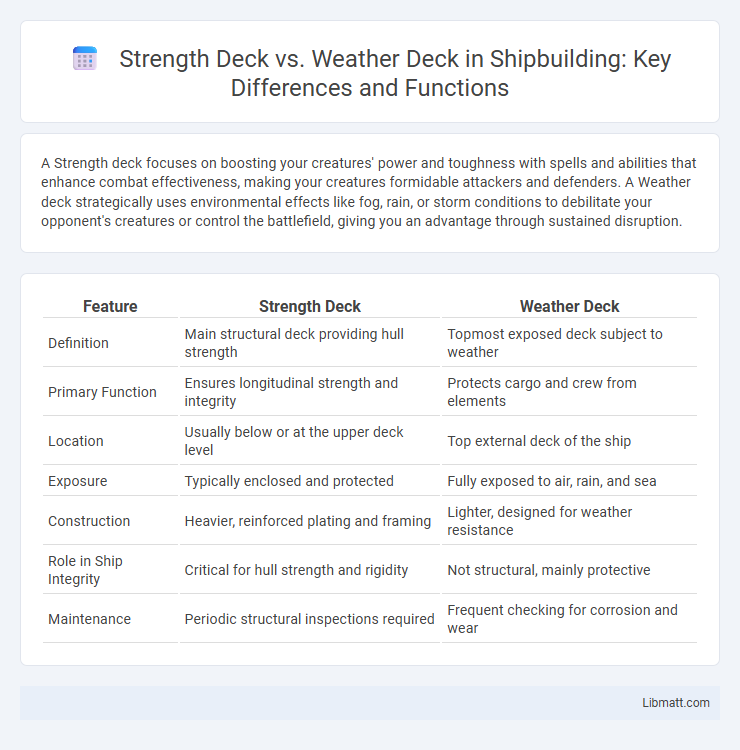A Strength deck focuses on boosting your creatures' power and toughness with spells and abilities that enhance combat effectiveness, making your creatures formidable attackers and defenders. A Weather deck strategically uses environmental effects like fog, rain, or storm conditions to debilitate your opponent's creatures or control the battlefield, giving you an advantage through sustained disruption.
Table of Comparison
| Feature | Strength Deck | Weather Deck |
|---|---|---|
| Definition | Main structural deck providing hull strength | Topmost exposed deck subject to weather |
| Primary Function | Ensures longitudinal strength and integrity | Protects cargo and crew from elements |
| Location | Usually below or at the upper deck level | Top external deck of the ship |
| Exposure | Typically enclosed and protected | Fully exposed to air, rain, and sea |
| Construction | Heavier, reinforced plating and framing | Lighter, designed for weather resistance |
| Role in Ship Integrity | Critical for hull strength and rigidity | Not structural, mainly protective |
| Maintenance | Periodic structural inspections required | Frequent checking for corrosion and wear |
Introduction: Understanding Strength Decks and Weather Decks
Strength decks emphasize powerful units that dominate through high attack values and strong abilities, often overwhelming opponents in direct combat. Weather decks, by contrast, focus on controlling the battlefield by applying weather effects such as fog, rain, or frost, which weaken enemy units over time and disrupt their strategies. Mastery of these decks requires balancing raw power with tactical manipulation of environmental conditions to secure victory.
Key Differences Between Strength Deck and Weather Deck
Strength Decks prioritize high-attack units and overwhelming power to dominate the battlefield quickly, while Weather Decks specialize in controlling the environment by applying debilitating weather effects that weaken enemy units. Your choice depends on whether you prefer direct damage output or strategic manipulation of unit stats through rain, fog, or frost. Strength Decks rely on raw force and synergy between powerful cards, whereas Weather Decks emphasize timing, control, and countering opponent strategies by altering battlefield conditions.
Structural Roles of Strength Decks in Ships
Strength decks in ships serve as primary structural components, providing rigidity and distributing loads throughout the hull to maintain integrity under various sea conditions. These decks are critical in resisting bending moments and shear forces caused by wave impacts and cargo weight, ensuring overall stability. Unlike weather decks, which primarily protect against environmental exposure, strength decks directly contribute to the ship's longitudinal strength and structural resilience.
Functional Purpose of Weather Decks
Weather decks are designed primarily to exploit environmental conditions such as rain, mist, or harsh sunlight to weaken opponents' strategies and bolster weather-dependent cards. Unlike strength decks that focus on maximizing raw power and direct combat advantages, weather decks aim to control the battlefield by inflicting continuous status effects that degrade enemy units over time. This strategic control disrupts opponent synergy and forces adaptation, making weather decks valuable for stalling and attrition-based gameplay approaches.
Design Features Unique to Strength Decks
Strength decks feature reinforced construction with thicker, high-density materials providing superior durability against heavy impacts. Their textured grip surfaces are specifically engineered for enhanced traction and control in strenuous activities, differentiating them from weather decks designed mainly for resistance to environmental elements. Unique to strength decks are strategically placed shock-absorbing layers that minimize vibration and improve overall stability during intense performance.
Weather Deck Construction and Exposure Challenges
Weather Deck construction requires materials and coatings that withstand continuous exposure to harsh environmental conditions like UV radiation, saltwater, and temperature fluctuations, which can accelerate corrosion and structural fatigue. Strength decks, typically found below weather decks, benefit from more controlled environments but must support heavy loads and resist dynamic stresses without compromising overall vessel integrity. Your design choices in weather decks must balance durability, corrosion resistance, and maintenance accessibility to mitigate exposure challenges effectively.
Material Selection for Strength vs Weather Decks
Material selection for strength decks centers on durability and load-bearing capacity, often utilizing dense hardwoods like oak or engineered composites engineered for high compression strength. Weather decks prioritize resistance to environmental factors such as moisture, UV radiation, and temperature fluctuations, favoring materials like treated softwoods, tropical hardwoods, or weather-resistant polymers with protective finishes. Your deck's longevity and performance depend on choosing materials that align precisely with these structural and environmental demands.
Operational Considerations: Strength Deck vs Weather Deck
Operational considerations for the Strength Deck versus the Weather Deck revolve around structural integrity under varying environmental conditions. The Strength Deck is engineered to withstand high mechanical loads and heavy traffic, making it ideal for infrastructure requiring enhanced durability, whereas the Weather Deck emphasizes corrosion resistance and waterproofing to protect against harsh climatic impacts like rain, snow, and UV exposure. Maintenance protocols for the Strength Deck typically focus on load stress monitoring, while the Weather Deck requires regular inspection for surface degradation and sealant integrity to ensure long-term performance.
Maintenance and Inspection: Strength Decks Compared to Weather Decks
Strength decks typically require more frequent maintenance and inspections due to their structural complexity and load-bearing functions. Weather decks are designed to withstand environmental exposure but often need regular surface treatments and quick repairs to prevent corrosion and material degradation. You should schedule routine inspections for both deck types to ensure safety and longevity, focusing on stress points in strength decks and protective coatings in weather decks.
Conclusion: Choosing Between Strength Deck and Weather Deck
Choosing between a Strength Deck and a Weather Deck depends on your preferred playstyle and strategic goals. Strength Decks excel in consistent, high-value unit deployment ideal for direct confrontations, while Weather Decks specialize in controlling the battlefield by weakening enemy units through environmental effects. Assessing your tactics and the meta will help you optimize your deck choice to maximize your competitive edge.
Strength deck vs weather deck Infographic

 libmatt.com
libmatt.com